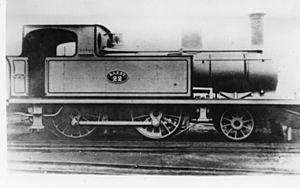Barry Railway Class C facts for kids
Quick facts for kids Barry Railway Class C |
|
 |
|
| Barry Railway Class C 2-4-0T | |
| Power type | Steam |
|---|---|
| Designer | J. H. Hosgood |
| Builder | Sharp Stewart |
| Build date | 1889–1890 |
| Total production | 4 |
| Configuration | 2-4-0T altered to 2-4-2T |
| UIC classification | 1B n2t altered to 1B1 n2t |
| Gauge | 4 ft 8 1⁄2 in (1,435 mm) standard gauge |
| Driver diameter | 5 ft 3 in (1.600 m) |
| Trailing wheel diameter | 3 ft 6 in (1.067 m) |
| Wheelbase | 15 ft 3 in (4.648 m) |
| Locomotive weight | 41 long tons 2 cwt (92,100 lb or 41.8 t) (46.0 short tons) |
| Fuel type | Coal |
| Boiler pressure | 150 psi (1.03 MPa) |
| Cylinders | Two inside |
| Cylinder size | 17 in × 24 in (432 mm × 610 mm) |
| Tractive effort | 14,040 lbf (62.45 kN) |
| Delivered | 1889–1890 |
| Withdrawn | 1898–1928 |
| Disposition | All scrapped |
The Barry Railway Class C was a type of steam locomotive used by the Barry Railway in South Wales. These engines were designed by J. H. Hosgood and built by Sharp Stewart. They were first made between 1889 and 1890.
Contents
What They Did
These locomotives were the first passenger trains built especially for the Barry Railway company. They were used to pull passenger trains between Barry and Cogan. They also ran on the Cardiff branch line.
Later, on August 14, 1893, the Barry Railway started running trains all the way from Barry to Cardiff Riverside station. This was a big step for the company.
A Tricky Start
On the very first day of the new Barry to Cardiff service, a Class C locomotive, number 21, had the honor of pulling the first train. But something unexpected happened! It went off the tracks (derailed) at a sharp curve called Cogan Junction. This caused delays for several hours on both the Barry and Taff Vale railways.
Changing Their Wheels
The Class C locomotives, along with the Class G, handled the Barry–Cardiff service. This was until the Class J engines arrived in 1897. The Class C engines had a problem: they couldn't carry enough fuel or water for the longer trips.
Because of this, in June 1898, locomotives numbers 21 and 22 were taken to the Barry Locomotive Works. Their wheel arrangement was changed. They went from a 2-4-0T design to a 2-4-2T design. This change helped them carry more and be more stable.
New Jobs for the Engines
After their wheels were changed, these locomotives returned to duty. They made a limited return to the Cardiff service. However, they were often given other important jobs.
For example, locomotive number 21 was used to pull special carriages. These included the Directors' saloon, the Engineer's saloon, and the Manager's Truck. Locomotive number 22 often pulled trains carrying coal miners. It also worked on lighter passenger trains on the Vale of Glamorgan line.
In 1914, two of the Barry Railway's steam railmotors were changed into special coaches. These were called the "vestibule set." Locomotives 21 and 22 were used to pull this train on the Barry to Bridgend service.
What Happened to Them
Two of the Class C locomotives were sold off quite early. These were numbers 37 and 52, which were both retired and sold in 1898. Number 37 stayed as a 2-4-0T engine. Number 52 was changed to a 2-4-2T just before it was sold.
| Barry number | Date of sale | Purchaser | Date passed to GWR | GWR numbers | Withdrawn |
|---|---|---|---|---|---|
| 37 | August 1898 | Port Talbot Railway | 1922 | 1189 | November 1926 |
| 52 | November 1898 | Port Talbot Railway | 1922 | 1326 | August 1930 |
Final Retirement
The two remaining locomotives, numbers 21 and 22, became part of the Great Western Railway in 1922. Number 21 was retired in 1926. Number 22 was retired in 1928. Sadly, none of these locomotives were saved. They were all scrapped.
How They Were Numbered
| Year | Quantity | Manufacturer | Serial numbers | Barry numbers | GWR numbers |
|---|---|---|---|---|---|
| 1889 | 2 | Sharp Stewart | 3528–3529 | 21–22 | 1322–1323 |
| 1890 | 2 | Sharp Stewart | 3610, 3626 | 37, 52 | 783–784 |

